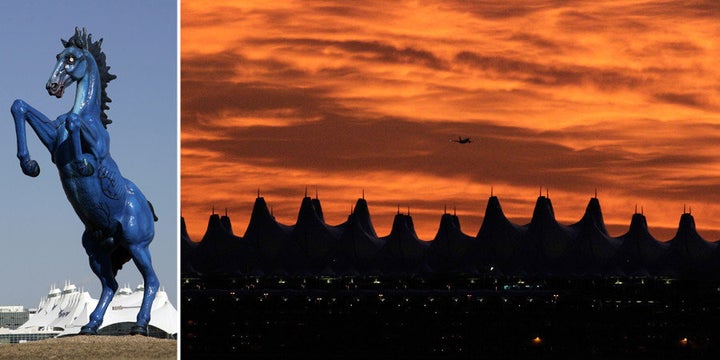
The controversial and attention-grabbing blue mustang sculpture at Denver International Airport is eligible for removal soon, 9News reports.
The sculpture titled simply, "Mustang," turns five years old on February 11, meaning the city can start accepting petitions to remove the art piece.
"People's view of public art changes as they look at it," Erin Trapp, director of the Denver Office of Cultural Affairs told 5280 after the mustang was installed. Trapp then said that the city would not consider removing it until 2013.
Greeting visitors and returning residents of Colorado with its fiery yellow-red eyes, the sculpture has been an icon both beloved and hated. It has even been unofficially known by such names as the "Denver Demon Mustang," "Bluecifer," "DIAblo," and "Satan's Stallion."
A Denver art panel commissioned $300,000 to sculptor Luis Jimenez to create the 32-foot fiberglass horse before DIA was opened, according to Westword. After Jimenez missed completion deadlines, the city filed a lawsuit to push its completion.
In 2006 while completing the mustang, an unsecured piece of the 9,000 pound sculpture fell on 66-year-old Jimenez killing him. The sculpture was installed two years later posthumously, and the city ended up paying $650,000 -- or more than double -- what it had originally intended.
"It will forever incite dialogue, promote dialogue and discussion," said then-President of Denver City Council Michael Hancock at the mustang's dedication event four years ago.
Then-Mayor of Denver John Hickenlooper insisted he liked it.
"Not only is it (Jimenez's) largest sculpture, but I think it's also his most powerful sculpture in that sense that it has so much energy that is controlled within it," Hickenlooper said at the dedication ceremony.
Since Jimenez's death, the sculpture has often been called "cursed." Others however, just hate it.
"It's definitely achieved its purpose of being memorable," Rachel Hultin told The New York Times the year after the horse was installed at DIA. At the time she created byebyebluemustang.com, a website that no longer exists but expressed a common desire to see the mustang go.
Today there are Facebook pages that express support for the mustang. But on Feb. 11, "Mustang" turns five and public comment has reopened the discussion about the sculpture's fate.